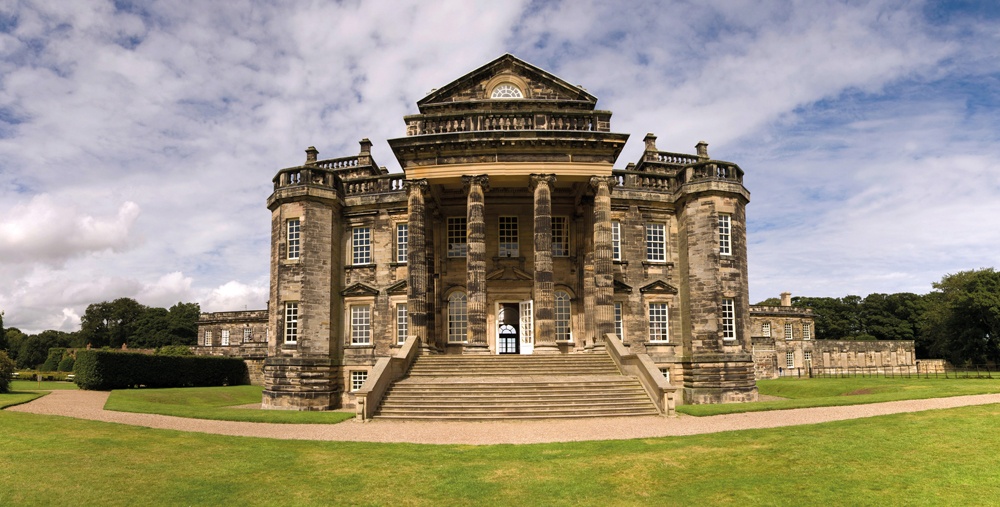Saving Seaton Delaval Hall

After taking over Seaton Delaval Hall in 2009 the National Trust had one priority: to stop the place falling down.
You know when you buy a house and start making a to-do list, but it all feels a little bit daunting? Well imagine what it was like for the National Trust, when they were handed the keys to Seaton Delaval Hall in 2009. Suddenly they had this vast Northumberland estate, which was designed by Sir John Vanbrugh (who also designed Castle Howard and Blenheim Palace), but any architectural sparkle had been greatly dimmed by a fire (in 1822) and neglect (it was roofless for a while). It was the to-do list of nightmares.
But first, to avoid underestimating the significance of the task, it’s worth putting the hall in context. The story began in 1066, when the Delavals came over from Normandy, led by William the Conqueror – the land where the hall now sits was given as a reward for the family’s efforts during the Battle of Hastings. Over the following centuries they used the land to produce salt, coal and glass, making upgrades to the mouth of Seaton Burn in the 1600s and 1700s by adding piers and sluice gates – that area became known as Seaton Sluice.
It was in the 1720s that Admiral George Delaval commissioned Sir John Vanbrugh, the most famous architect of the time, to build Seaton Delaval Hall. Unfortunately, both men died before construction was finished, and in the early 1800s the estate passed to the Astley family. Further misfortune came in 1822, when a fire severely damaged the hall. Sir Jacob Astley neglected to repair the damage, and the hall was derelict for decades.
In 1860 John Dobson was commissioned to carry out some repairs, but the hall was never properly fixed, and in the 20th century, Sir Edward Astley inherited the hall with its leaky roof and broken windows. He did his best to patch things up and remodel the gardens, but when he died in 2007, his son turned to the National Trust, who, after raising donations, took on the hall in 2009, opening its doors (carefully, lest they fall off) to the public in May 2010.
Justine James, who runs the site for the National Trust, explains what work has been done so far: ‘In the time that we’ve been here we have put in the temporary car park and built the ticket hut and shop, and made that end accessible. We’ve built a little café in one of the stables, so we’ve got a little refreshments offer, and we’ve installed toilets, although they’re portable. The East Wing’s had a new roof. The West Wing has been rewired and then the next thing that we did was the Central Hall after we got the SITA money.’
The SITA money she’s referring to was a grant from waste management company SITA , which came at a very important time: Seaton Delaval’s treasures were about to crumble.
‘We were going to have to close the Central Hall, probably by January 2014,’ says Justine, who previously worked at another trust property, Cragside. ‘But the SITA money landed, which meant we could do major amounts of masonry work and repointing. The black and white marble floor was disintegrating – that has now been consolidated. And the muses, the 7ft tall statues in the Central Hall, have been consolidated, because bits were dropping off.’
Not that the programme of works was without a hitch – renovations to the chimneys had to be halted due to nesting jackdaws, which are believed to have caused the 1822 fire. ‘They always used to nest in the chimneys, which were wide open,’ explains Justine, ‘And we’d got to the point where we were ready to cap off the chimneys, but they’d stolen a march and made their nests, so we had to stop while they got on and had their chicks.’
Sewage and drainage have also been troublesome – a third of a million pounds had to be spent connecting the hall to the mains, work which was only completed in March. ‘You can see where the huge sums of money go,’ Justine tells us. ‘A lot of it is not particularly glamorous, it’s not sexy conservation stuff, but without that, without connecting to main sewage and drainage, we couldn’t cope with the impact that surface water and rain was having, and we also couldn’t cope with... the outcome, shall we call it, of 50,000 visitors!’
Now though, there’s a pause in the renovation work, with 2015 and 2016 scheduled for what Justine describes as ‘business as usual’, though she says it with her fingers in the air as quote marks – ‘In other words, we just have visitors, apart from there is still remedial stuff going on, where bits drop off and we have to put them back on, but not on the same scale as in 2012, when massive lumps of things were dropping off.’
The stables are an example of that remedial work. Built in the 1700s and based on the grand design of the stables at Hopetoun House in West Lothian, Sir Francis Blake Delaval was so pleased with them that he held a dinner party in the stables to celebrate their completion. However, one of the stalls recently started leaning, as supporting metalwork has rusted away. Now an expert is needed to repair them – more cost. ‘Every time we turn around,’ says Justine, ‘We find something else. Struggling, struggling!’
But the future is bright. The plan is for further major works, subject to funding, to start again in 2017, when Seaton Delaval Hall will be at the top of the National Trust’s list of priorities – the property will then be brought more into line with what you may expect from a National Trust experience, such as play areas and a big café, and further renovation will also be carried out, highlighting the estate’s significance.
‘Since we acquired the site we’ve carried out a conservation management plan,’ Justine explains, ‘So you get somebody neutral to come and tell you what you’ve got and give you ideas of how significant various elements are. Having done that we found out that this is probably the most complete Vanbrugh building and landscape.
‘If you go somewhere like Castle Howard or Blenheim Palace they’ve changed theirs as fashion has come and gone, but because this place was empty, the original Vanbrugh landscape is still there. It’s massively significant and the fact it’s up here in the little old North East just makes it even more astonishing.’
What she’s particularly keen to happen in the following years is the renewal of vistas and walkways, including improving the site’s links to the sea, converting what is currently a relatively small site (by National Trust standards) into the magnificent estate it once was.
‘But I’m looking very long-term into the future,’ she clarifies. ‘I do think, once we’re able to better articulate the significance of the place and how beautiful it is, we’ll be easily nudging up towards figures more like Gibside and Cragside’s. Absolutely.’
We can’t wait.
Seaton Delaval Hall
The Avenue, Seaton Sluice NE26 4QR
0191 237 9100
Who Was Sir John Vanbrugh?
Sir John Vanbrugh was born in London in 1664 but grew up in Chester after his family fled the plague. As an adult he became involved in politics and had a role in the deposition of James II, which led to him being arrested for espionage in France and imprisoned at the Bastille.
After returning to England he began writing plays, but eventually turned to architecture. With no formal training and little experience, he formed a working relationship with Nicholas Hawksmoor, who had worked as a clerk for Sir Christopher Wren – together they had much success.
The style of his designs became known as English baroque, and the most famous examples are Castle Howard, Blenheim Palace and Seaton Delaval Hall, which was completed in 1726, two years after Sir John died of an asthma attack – it’s known as his final masterpiece.




